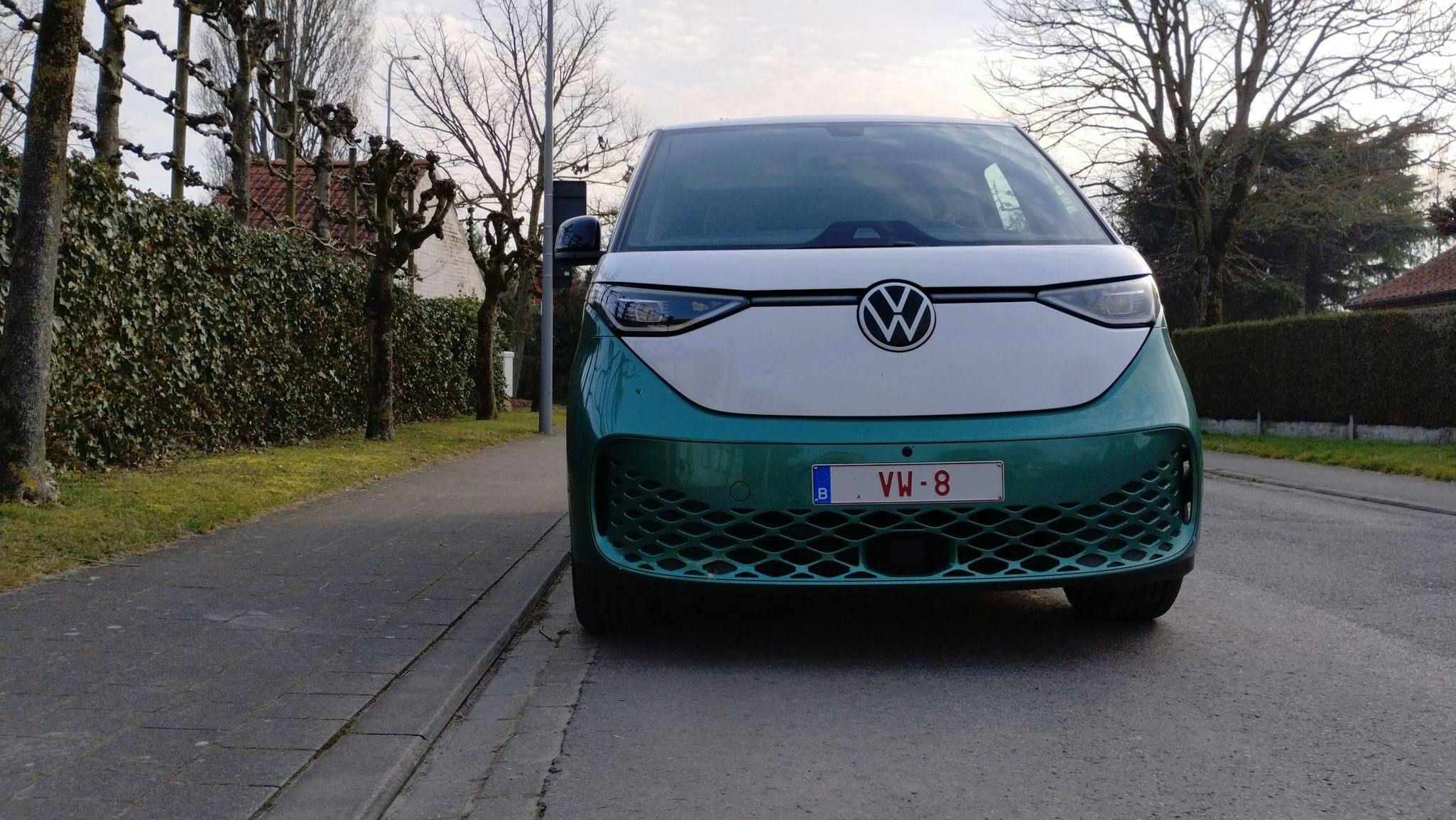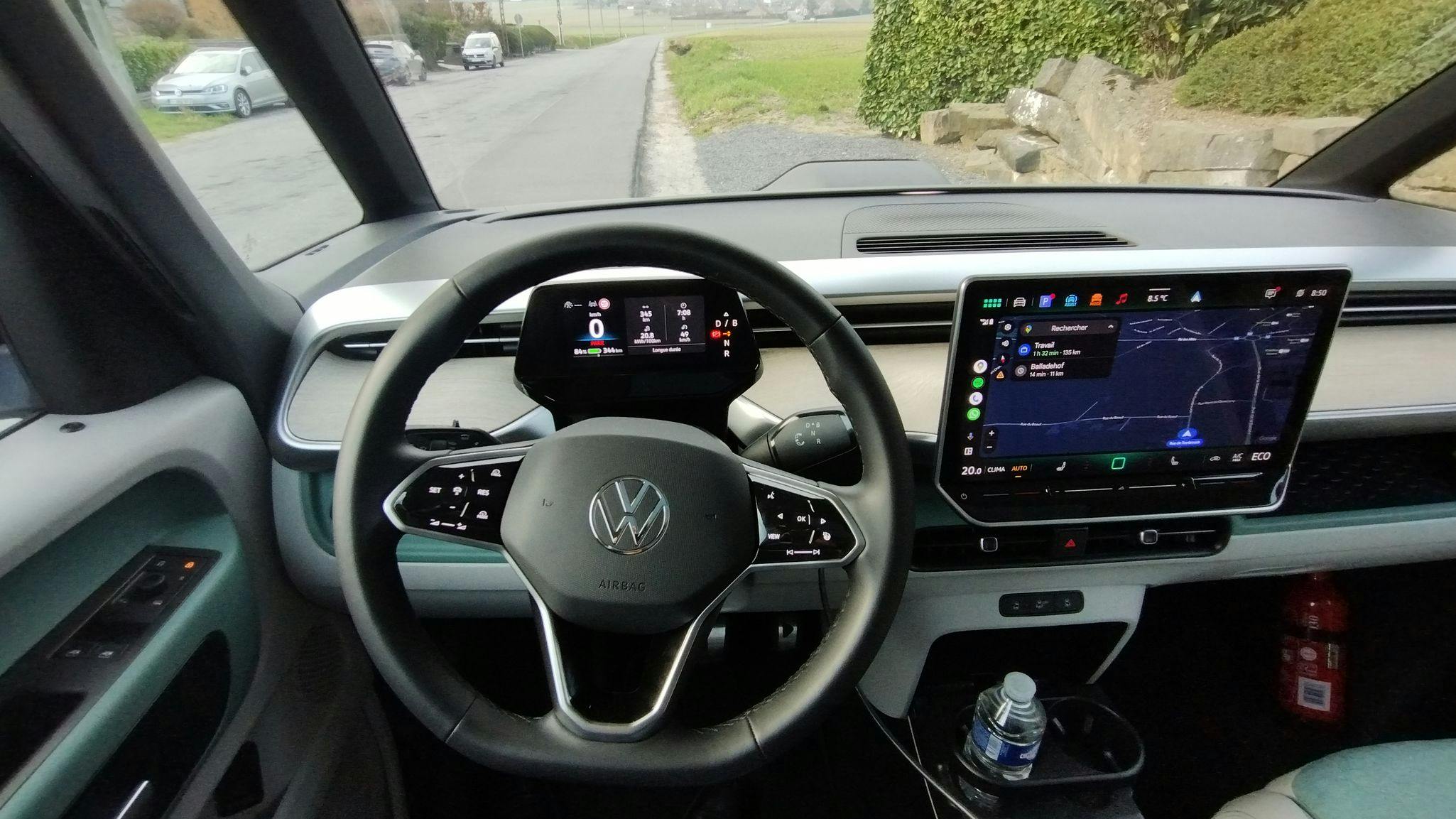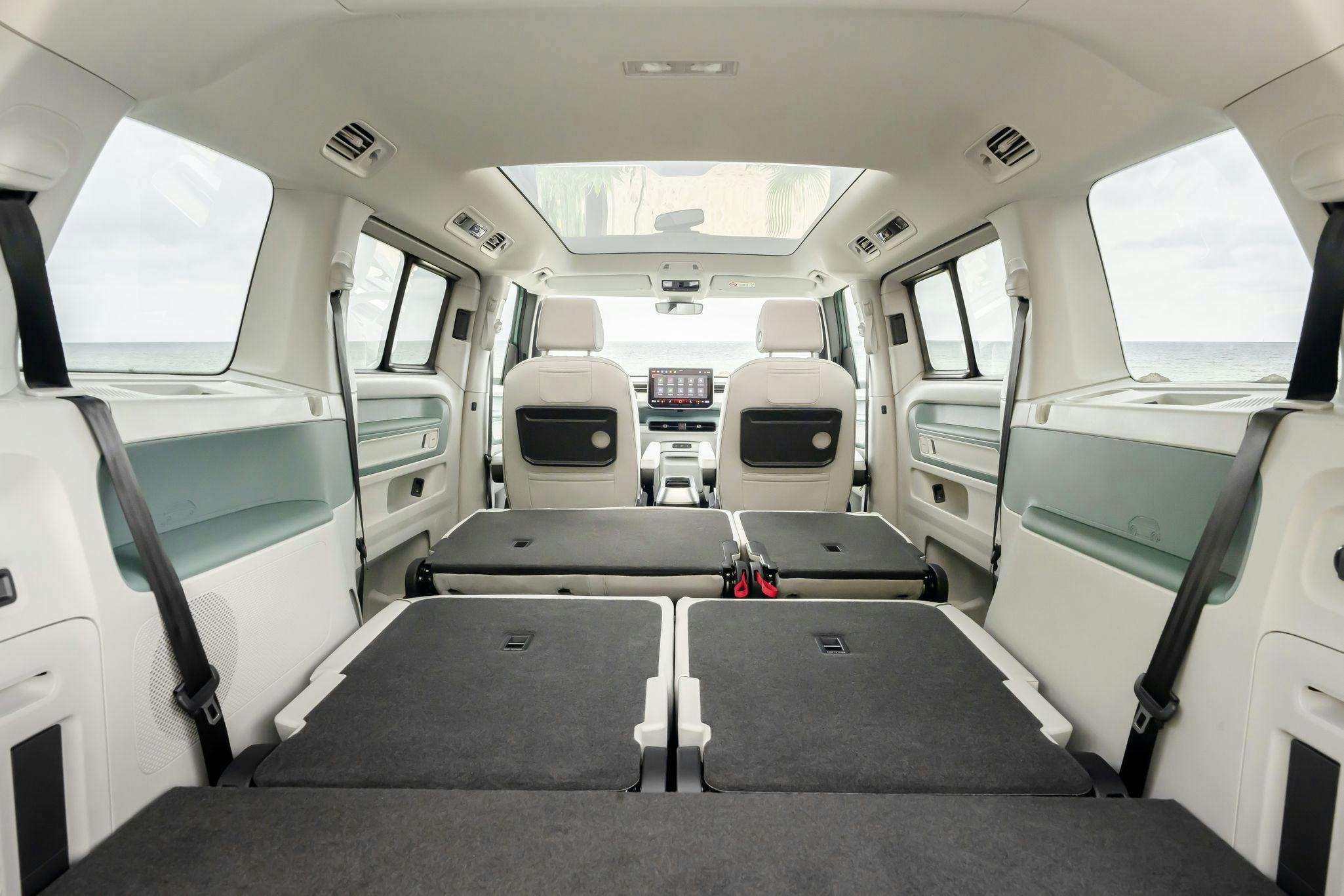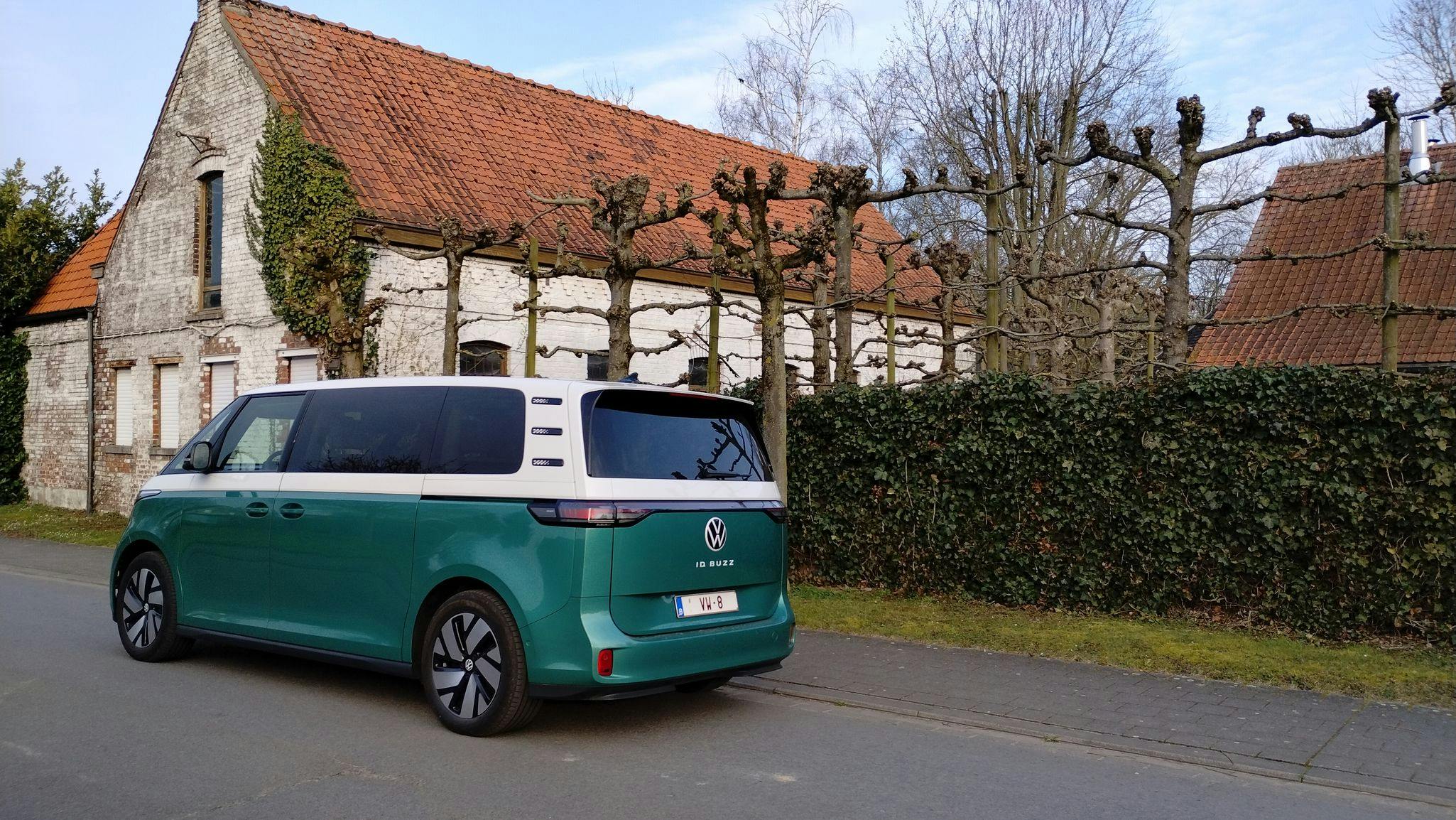
It’s impossible to overlook the Volkswagen ID.Buzz; particularly due to its distinctive two-toned exterior that brings back memories of its iconic predecessor from the 1950s and '60s. However, this modern version graces us in the 21st century as an all-electric vehicle.
Before the introduction of the LWB version, the ID.Buzz was offered primarily as a five-seater model designed for family use in Europe. However, this limitation has been addressed with the launch of the new ID.Buzz LWB. The term "LWB" stands for "long wheelbase," which indicates an extended chassis providing an additional length of 25 centimeters compared to previous models. Consequently, this modification allows for seven genuine seating positions along with enhanced storage space and increased driving range.
The updated vehicle comes equipped with an improved battery capacity of 86 kilowatt-hours (usable) or 91 kilowatt-hours (gross), representing a gain of 7 kilowatt-hours over the original ID.Buzz fitted with similar drive systems. Although the increment may seem modest, every bit contributes positively towards performance enhancement. Let us revisit these technical details shortly before we proceed further into our discussion.
Now, let’s get behind the steering wheel of this compact yet spacious four-meter-ninety-six-long van during a highway journey through picturesque landscapes located around Kortrijk—a charming city situated within Belgium’s rural region known as Western Flanders.

Combi bus
Initiating this adventure involves pressing your foot on the brake and manually shifting the gear selector located behind the steering wheel. With that out of the way, we set off amid envious glances from those around us due to our vehicle’s neo-retro design. It feels so cool that one might even want to return their gaze with a playful surf nod.
Tonight promises excitement; following a lively celebration where we’ll supply music, my companions—myself included—and all our equipment will settle down using air beds inside what seems like another world beyond city lights. Apart from myself and the trio who squeezed into the trunk when the back seat was lowered, everything else followed: suitcases, camping mats, blankets, sound system components including amplifiers, loudspeakers, boxes full of cords, microphones, plus a rotating light fixture designed to cast vibrant patterns across dark spaces. All these items comfortably stowed under the hatchback (an electric option available) over designated spots meant for storing essential tools such as first-aid kits and reflective triangles—all neatly arranged beneath a retractable mesh barrier protecting valuables but not needing removal here.
The microphone stands had to find room tucked away past the second-row seating area. Moreover, considering future convenience, folding mechanisms allow direct entry via side doors (again optional power assistance provided). This setup ensures ease during loading processes ensuring every bit fits just right whether preparing for grand adventures or cozy getaways alike.

Holiday Atmosphere
Seated on the right side behind the wheel, you're greeted by an expansive dashboard that seems boundless. This expanse offers little usability but fear not—there’s a glove box located ahead of the passenger seat above another storage space known as the glove compartment. Similar compartments can be found scattered around the interior cabin. Additionally, close to the steering wheel, there is a dedicated slot equipped with two USB-C ports designed specifically for smartphone connectivity. However, these connectors become redundant should your device support wireless charging since the vehicle comes fitted with an inductive charger receptacle instead. Furthermore, both the front-seat occupant and rear passengers have access to additional USB-C connections.
The car ensures comprehensive connectivity within this inviting atmosphere, notwithstanding the presence of some plastic elements. To adjust lighting levels, simply slide your fingers across a touch-sensitive zone situated atop the ceiling which controls the transparency of the electrochromic panoramic sunroof—an entertaining feature indeed!
Moreover, the insulation provided by the acoustic glass (yes, available at extra cost) envelops occupants in quietude so profound that even loud noises from outside fade into insignificance. Interestingly enough, all this tranquility exists alongside an impressively hushed engine operation!
Tchiki boum
Could you picture the stereotypical scene of individuals swaying to the rhythm, meandering through their journey aboard a verdant and ivory-hued bus? This scenario aptly describes our experience (despite none of us being true aficionados). The ID.Buzz promotes an unhurried adventure. On highways too, every stretch seems transformed under its influence. Thanks to the powerful 286 horsepower (210 kilowatts) engine mounted at the back, we effortlessly command the flow of traffic; occupying the far-left lane comes naturally as a result. With impressive torque of 560 Newton-meters, accelerating becomes almost effortless—so much so that achieving 0-100 km/h happens within just 7.9 seconds when pressed appropriately. Despite these capabilities, the top speed caps off at 160 kilometers per hour.
However, navigating curves and circles demands caution owing to the sizeable dimensions of the vehicle. Although positioned lower due to the substantial battery contributing significantly to overall mass, it retains its bulky appearance akin to a rectangular carton. Nevertheless, Volkswagen’s adept refinement ensures optimal airflow management, enabling extended trips efficiently supported by improved fuel economy across all models in the VW ID lineup.

Traveller
In rural areas, achieving energy consumption under 19 kWh per 100 km is feasible. However, maintaining this efficiency becomes challenging above speeds of 100 km/h, where the average rises to over 23 kWh per 100 km. Fortunately, we experienced mild springlike temperatures during our journey, allowing us to aim for approximately 300 km on highways and exceeding 400 km overall travel distance. Regardless of seasonal conditions, planning rest stops every two hours along the highway is advisable; longer breaks up to 2.5 hours might be needed depending on favorable weather. When stopping at a charging point, align the rear-right side of your vehicle close to the electrical outlet. While the peak charging rate reaches 200 kW, both the charger’s hardware and onboard software determine the effective output—often around 125 kW. Consequently, expect about half an hour required for replenishing enough charge to cover another 200 kilometers unless winter climate factors intervene. Additionally, for colder periods, features like heated backseats and optional windshield de-icing systems enhance comfort within the cabin.

Limited weight
Whether you're setting up camp or disposing of recyclables, towing a trailer becomes feasible due to the electric tow hitch capable of handling up to 1,000 kg. However, be cautious as adding passengers would push the overall weight past 3.5 tonnes, necessitating an adequate driving license. Keep in mind though; the vehicle has a maximum authorized gross weight of just 3,340 kg. Thus, fitting seven rugby players along with their equipment inside won’t work since the luggage compartment offers only 306 liters of space.
When all seating positions are lowered transforming your ID.Buzz into a makeshift cargo van, the available volume increases significantly to 2,469 liters, but even so, it may still fall short for large-scale moving tasks. Primarily designed as a family vehicle rather than a utility transport, it excels more in providing comfort and ambiance suited for recreational activities and daily use. Its detachable central display facilitates seamless integration between navigation systems and multimedia entertainment features.
Lastly, although sizable, the compact turning radius coupled with built-in camera assistance makes maneuvering within urban environments easier—provided there is enough clearance of about five meters plus required safety distances—to execute maneuvers such as parallel parking efficiently.

The Painful Price
The extended-wheelbase ID.Buzz is fantastic. Its sleek design makes it an enjoyable van both visually and during drives. With its sizable 86kWh battery, it promises exciting adventures and travel opportunities without significant limitations, although cold weather might require adjusting those expectations somewhat. Starting at around €62,000 inclusive of VAT (€56,000 for the standard version), our Belgian-market test vehicle in Pro trim came fully loaded with numerous upgrades like the infotainment package costing €1,657, the comfort package priced at €3,091, additional features such as the tow bar, sliding doors, and power rear gate totaling €3,130, bi-color paint job adding another layer of style, advanced driver assistance systems amounting to €2,585, and luxurious interiors worth €4,114—bringing the total up to a staggering €85,722! Quite impressive indeed. For comparison, the seven-seat ID.Buzz Pro starts at about €58,400 in France, whereas in Switzerland, the base price for the same configuration stands at approximately 71,000 CHF. Meanwhile, Canadians would be looking at nearly $81,000 CAD. That sums things up nicely.
(MH with Olivier Duquesne – Source: Volkswagen – Images: © Olivier Duquesne & Volkswagen)

Our website uses cookies to improve your experience. Learn more